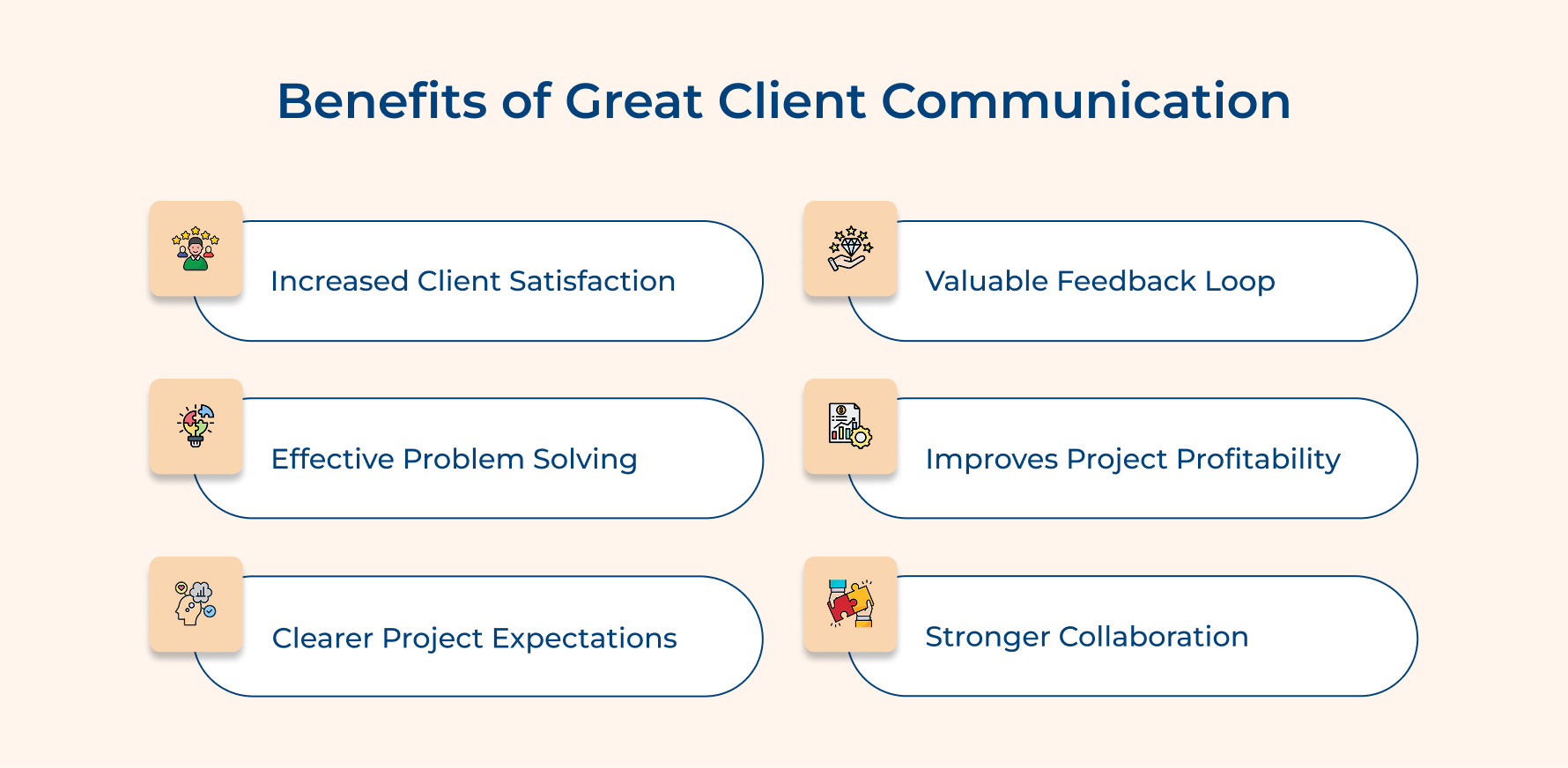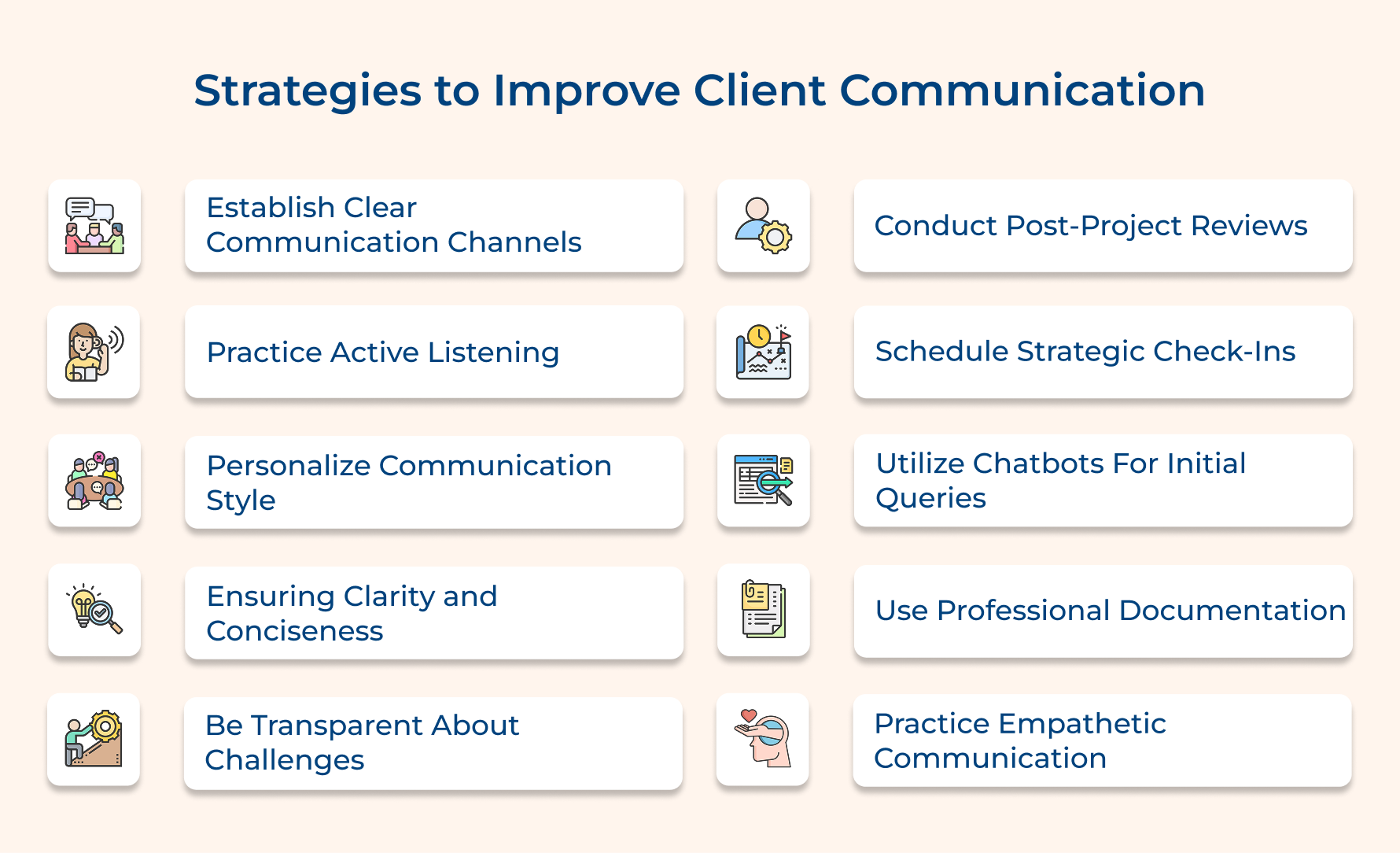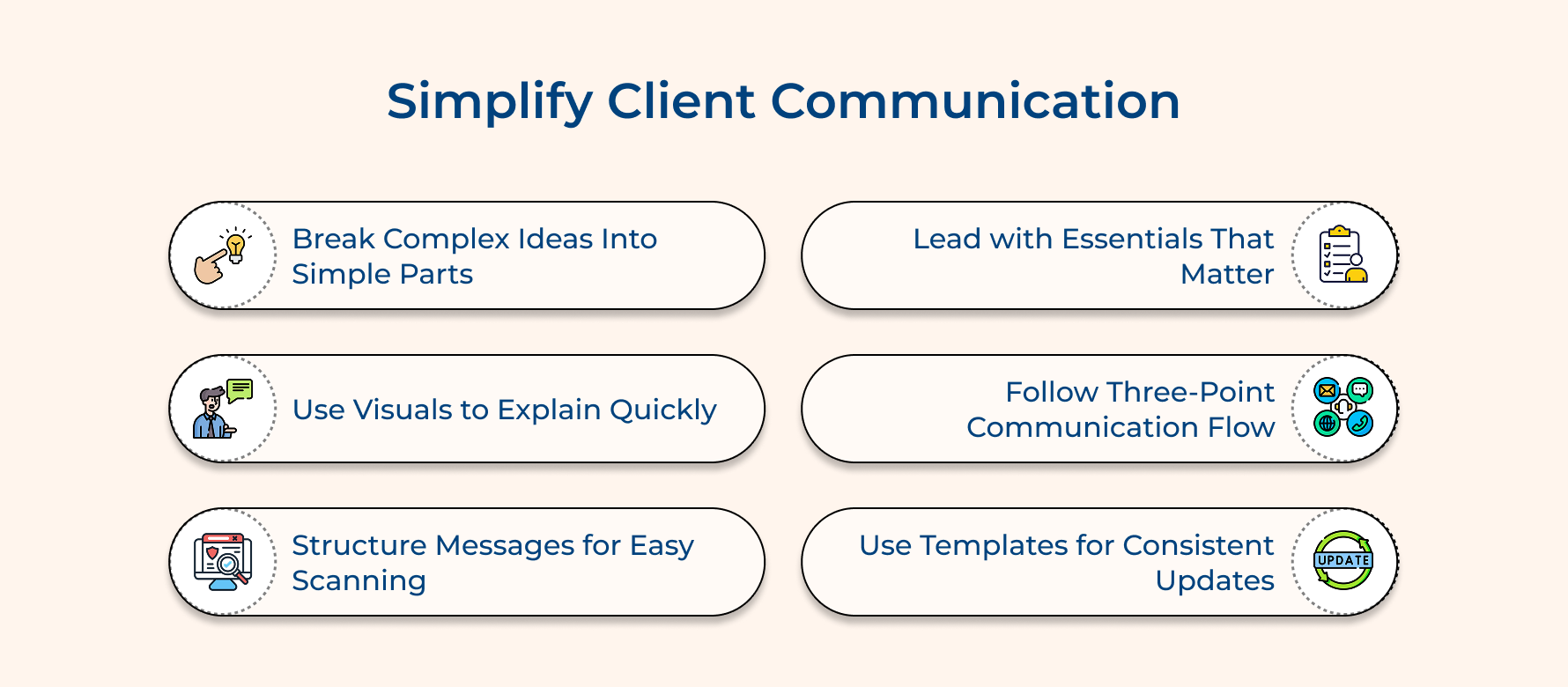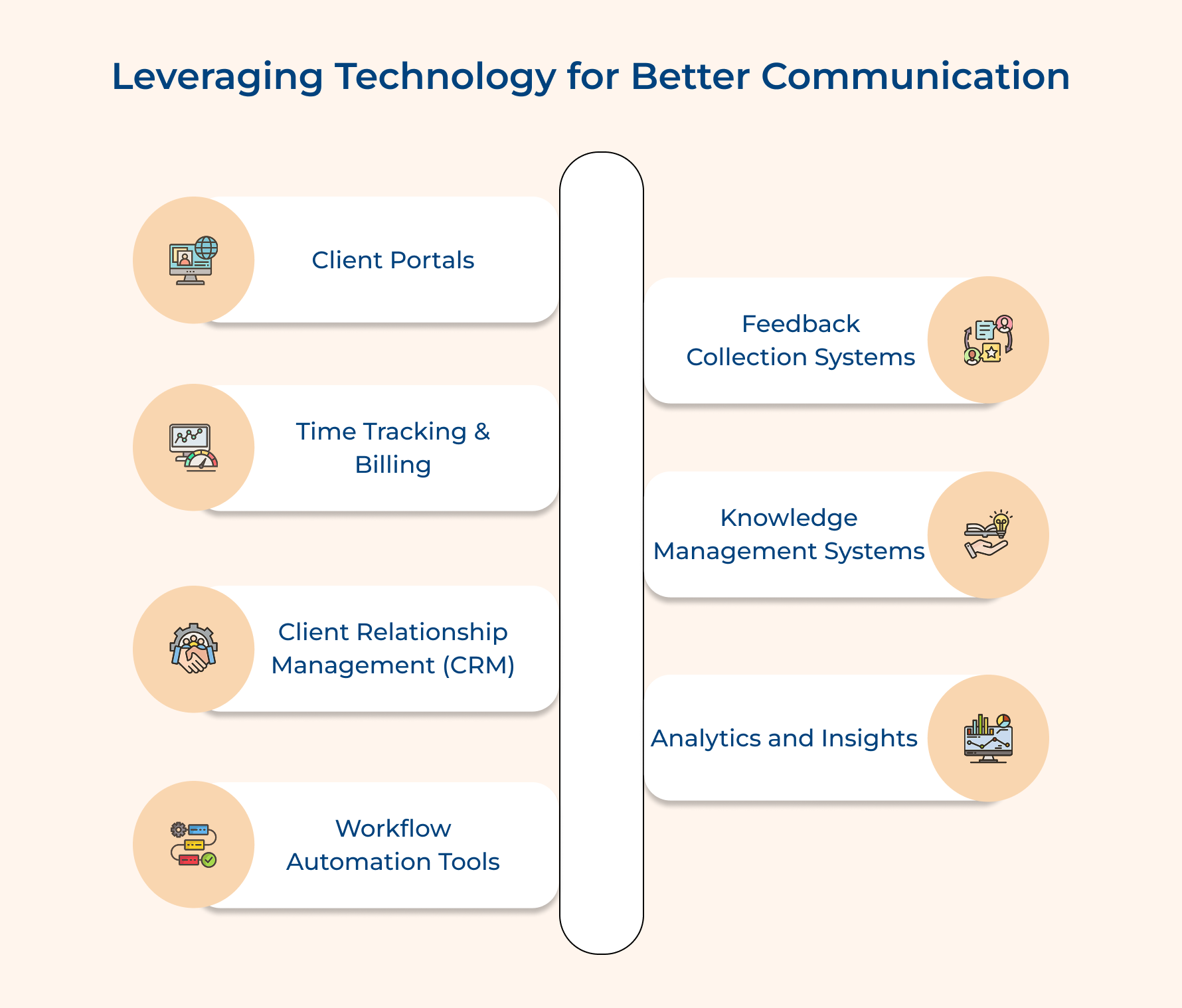10 Best Ways to Enhance Client Communication & Its Benefits
- What is Client Communication?
- Benefits of Great Client Communication
- How to Improve Client Communication: 10 Strategies
- Leveraging Technology for Better Communication
- Unique Challenges Agencies Face in Client Communication
- The Power of Effective Communication in Professional Services
- FAQs about Client Communication

Key Highlights:
- Transparent client communication helps manage expectations and ensures projects stay on track.
- Active listening strengthens relationships by understanding client needs and ensuring solutions align with their goals.
- Effective communication drives business growth and enhances client satisfaction, resulting in better outcomes.
Ever felt like client relationships can be a bit of a balancing act? Misaligned expectations as well as shaky communication can quickly spiral into misunderstandings, strained partnerships, and even missed opportunities.
But here’s the good news: it doesn’t have to be that way.
The secret to thriving client relationships lies in one simple yet powerful concept—clear and consistent communication. When done right, it builds trust and turns clients into long-term advocates.
Let’s dive deep into the art of client communication. From game-changing strategies to must-have tools, you’ll discover everything you need to create seamless interactions, exceed client expectations, and drive lasting success for your agency.
What is Client Communication?
Client communication refers to the structured exchange of information, feedback, and updates between professional services along with their clients. Various channels—such as emails, phone calls, meetings, and collaborative platforms—facilitate clarity as well as collaboration.
Effective client communication is crucial for understanding client needs, managing projects, and delivering successful outcomes for agencies.
Ensuring that both the agency and the client share a common understanding of project objectives, timelines, along with deliverables enhances client satisfaction.
Key objectives:
- Building trust: Open communication establishes a foundation of trust, which is essential for long-term relationships with clients.
- Managing expectations: Clearly defining project scopes, timelines, and potential challenges helps align expectations while reducing the risk of disappointment.
- Encouraging feedback: Actively incorporating client feedback allows agencies to improve services and demonstrates that client opinions matter.
Benefits of Great Client Communication
Great client communication isn’t just about talking, it’s about connecting and how! Let’s explore how it benefits your firm in the long run.
Increased client satisfaction: Clear communication shows clients you’re professional and reliable. When clients feel heard as well as valued, they stick around—and often spread the word about your services.
Effective problem-solving: When you’re in regular contact, it’s easier to spot and solve issues before they spiral out of control. Open conversations keep projects running smoothly and relationships stress-free.
Clearer project expectations: Good communication helps set clear expectations around project goals, timelines, and deliverables. It ensures there’s no confusion, so everyone knows exactly what to do and when.
Valuable feedback loop: Active conversations pave the way for valuable feedback. This helps you tweak strategies, deliver better results, and nail client needs. Plus, it sets the foundation for future wins.
Improves project profitability: Precise communication reduces costly mistakes, prevents scope creep, and cuts down on unnecessary revisions. It means projects stay on track and on budget.
Stronger collaboration: Good communication builds trust and encourages teamwork. It sparks innovative ideas, leads to creative solutions, and strengthens long-term partnerships. Win-win for everyone!
How to Improve Client Communication: 10 Strategies
Want to turn your client relationships from “meh” to magical? Whether you’re smoothing out misunderstandings or wowing clients with updates, these 10 strategies will help you level up.
1. Establish Clear Communication Channels
Say goodbye to the chaos of scattered messages and missed updates! Clear communication channels ensure everyone knows where and how to share information effectively, keeping confusion at bay as well as accountability high.
- Designate specific platforms: Assign tools for different purposes—emails for formal updates, messaging apps for quick queries, and project management software for task tracking.
- Prioritize by urgency: Create a hierarchy of channels based on message importance. Urgent updates? Use instant messaging. Non-urgent? Save it for the next scheduled call.
- Onboard with clarity: Document communication preferences during onboarding and share clear guidelines with your team to ensure everyone’s on the same page.
Build a communication matrix that spells out which channel to use for what. Set response time SOPs to avoid delays and include escalation paths for urgent matters.
2. Practice Active Listening
Active listening is your secret weapon for understanding client needs beyond the surface. It builds trust, strengthens relationships, and ensures your solutions align perfectly with their goals.
Here’s how to make active listening a game-changer:
1. Engage Fully in Conversations
- Avoid distractions and focus entirely on the client.
- Maintain eye contact (if in person or on video) and show genuine interest with affirming nods or comments.
2. Clarify and Confirm
- Take detailed notes: Capture important points during meetings.
- Repeat key points: Confirm your understanding by paraphrasing what the client said.
- Ask thoughtful questions: Dig deeper to uncover underlying concerns or expectations.
3. Summarize and Align
- Provide written recaps: After meetings, share bullet-pointed summaries highlighting key decisions and next steps.
- Invite feedback: Encourage clients to confirm or correct your understanding for clarity.
4. Apply the LAST Method
- Listen: Pay attention without interrupting.
- Acknowledge: Show empathy and validate their input.
- Summarize: Restate main points to confirm alignment.
- Take Action: Act on what was discussed promptly and effectively.
Make follow-ups a habit! A simple summary email not only keeps things on track but also reassures clients that their voices are heard and valued.
3. Personalize Communication Style
Imagine this: One client prefers concise, data-driven reports, while another thrives on storytelling and visual presentations. Adapting your approach to each ensures they feel understood and valued.
Recognizing and adapting to these preferences not only boosts engagement but also shows your commitment to personalized service.
1. Observe and Learn Early
- During onboarding, pay close attention to how your client communicates.
- Do they respond faster to emails, prefer instant messages, or schedule calls for updates?
2. Customize Your Approach
- Format matters: A spreadsheet may win over an analytical thinker, while a creative decision-maker might love visual mockups or storytelling presentations.
- Frequency counts: Some clients need frequent updates, while others trust you to deliver and only want major milestones.
3. Use Client Profiles
- Document preferences: Create a “client preference sheet” during onboarding, noting their communication style, frequency needs, and decision-making patterns.
- Share with your team: Ensure everyone interacting with the client aligns with their preferences.
4. Be Ready to Pivot
- Notice a client becoming less responsive to emails? Switch to a phone call or a quick video message. Staying flexible shows you’re proactive and attentive.
4. Ensuring Clarity and Conciseness
Clear communication isn’t just polite—it saves time, prevents misunderstandings, and ensures everyone is on the same page. Especially when dealing with intricate concepts, simplicity is key to helping clients make confident, informed decisions without feeling overwhelmed.
So how do you make things crystal clear?
1. Simplify the Complex
- Break big ideas into smaller, digestible bites. Think of it like turning a complicated recipe into easy-to-follow steps.
- Support your words with visuals like charts or infographics—they can explain what words alone can’t.
2. Structure for Scannability
- Use headers, bullet points, or numbered lists to make your messages easy to skim.
- Lead with the essentials: what they need to know, why it matters, and what’s next.
3. Pro Tips for Consistency
- Try the three-point rule: start with context, deliver the message, and wrap with the required action. It’s a foolproof way to keep your communication tight and to the point.
- Use templates for routine updates or reports. A polished, consistent format instantly sets a professional tone.
Example in Action:
Instead of saying:
“The deadline for feedback is approaching, we’d really appreciate your input to finalize the design and move forward.”
Try:
- Subject: Final Feedback Needed by [Date]
- Context: We’re finalizing the design.
- Message: Your input is critical to wrap up this phase.
- Action Required: Please share feedback by [specific date].
See how much easier that is to follow? Keep it clean, keep it simple, and everyone wins!
5. Be Transparent About Challenges
Transparency is the cornerstone of trust and sets the stage for managing client expectations smoothly. By addressing potential challenges early, you can prevent small issues from snowballing into major setbacks.
Openly sharing updates—including progress and roadblocks—creates space for collaborative problem-solving as well as strengthens client relationships.
Proactively highlight possible roadblocks during project planning and offer solutions alongside any challenges.
Regular status updates that balance transparency with reassurance keep clients informed and confident. A client communication strategy with clear protocols for communicating issues ensures everyone stays aligned, even when things get tricky.
6. Conduct Post-project Reviews
Post-project reviews are valuable for refining your communication game and boosting future performance. These sessions uncover gaps, highlight what worked, and show clients your commitment to continuous improvement.
Plan review meetings soon after project completion while everything’s still fresh. Use structured questions to assess communication effectiveness and gather actionable feedback.
Share lessons learned with your team to enhance future strategies. A standardized review template ensures no detail is missed, making each project a stepping stone toward an even stronger business relationship.
7. Schedule Strategic Check-ins
Regular check-ins maintain project momentum and alignment. They provide opportunities to address concerns before they become issues. Strategic timing of check-ins ensures efficient use of client time.
Set up recurring meetings at project milestones. Prepare focused agendas for each check-in. Document decisions and action items from each meeting.
Pro tips:
- Create a check-in schedule aligned with project milestones and deliverables.
- Develop standard agenda templates for different types of check-in meetings.
8. Utilize Chatbots for Initial Queries
Chatbots are game-changers for quick, consistent responses to common questions, freeing up your team’s time for more complex tasks. They help maintain smooth communication by providing instant answers while ensuring no inquiry is left unanswered.
- Set up chatbots with FAQs for quick responses.
- Ensure clear handoff paths to human support for tough questions.
- Regularly monitor and tweak chatbot interactions for accuracy.
Pro tip: Build an up-to-date FAQ database to keep chatbot responses sharp and relevant!
9. Use Professional Documentation
Professional documentation is key to clear communication and accountability, providing a solid reference for project decisions. It helps minimize misunderstandings and disputes.
- Create templates for common project documents for consistency.
- Maintain uniform formatting across all documents.
- Store documents in accessible shared locations for easy retrieval.
Pro tip: Set up a document hierarchy system to organize communication types and use version control to track updates efficiently.
10. Practice Empathetic Communication
Empathy is essential for building strong client relationships and trust. By understanding the client’s perspective and concerns, agencies can respond more effectively.
Instead of just replying, focus on listening to truly understand. Acknowledge the client’s concerns before jumping into solutions, and tailor your communication to their needs.
Train your team on emotional intelligence and empathetic communication.
Develop response templates that include empathetic language to address common client situations, ensuring a supportive and understanding tone of voice each time.
Leveraging Technology for Better Communication
How can leveraging technology improve your agency’s communication and enhance client relationships? Here are innovative ways agencies can use technology to enhance interactions.
Client Portals
Modern client portals offer a centralized hub for project communication and document sharing. Clients can track progress, approve deliverables, and view key metrics in real-time, all in one secure place.
Integrated messaging features ensure conversations stay on track, while built-in notifications keep clients updated without the email overload.
Time Tracking & Billing
Advanced time-tracking solutions bring transparency to project hours and resource usage.
Real-time reports break down task allocation, while integrated billing systems generate professional invoices with clear itemizations. Automated reminders and digital payments make the billing process smooth as well as efficient.
Client Relationship Management (CRM)
With a solid CRM system, you can track every client interaction, preference, and project detail in one place.
Automated reminders ensure no follow-up is missed, and integration with email platforms makes communication seamless, giving you valuable insights into each relationship.
Workflow Automation Tools
Streamline your agency’s workflow with tools that automate routine communication tasks. Pre-set templates send timely messages, task management systems keep everyone aligned.
Smart scheduling coordinates meetings across time zones, reducing admin work and improving efficiency
Feedback Collection Systems
Digital feedback platforms let you collect client input through surveys and forms at key stages.
Real-time reporting tools analyze this data, pinpointing areas for improvement while interactive rating systems offer immediate insights into client satisfaction.
Knowledge Management Systems
A centralized knowledge base stores everything from project documentation to communication best practices.
With smart search functionality, your team can quickly access essential information, and version control ensures everyone stays on the same page, while integrated training modules help new team members get up to speed.
Analytics and Insights
Data-driven analytics tools track key communication metrics like response times and client satisfaction scores, offering real-time insights to improve your strategy.
Predictive analytics help spot potential gaps before they become problems, while custom reporting helps refine communication tactics.
Unique Challenges Agencies Face in Client Communication
Agencies encounter specific communication challenges that can hinder success. Here are the unique obstacles and solutions to overcome them.
Misaligned Expectation
Agencies often struggle when clients have unrealistic project expectations.
How to fix: A comprehensive onboarding process with detailed project scope documentation helps establish clear expectations upfront. Creating success metrics together builds mutual understanding. Regular milestone check-ins paired with structured communication schedules ensure both parties stay aligned throughout the project lifecycle.
Limited Availability of Clients
Many clients struggle to provide timely feedback or attend meetings due to busy schedules.
Ways to solve: Setting up structured communication protocols helps maintain progress through asynchronous tools like recorded updates. Implementing project management software streamlines communication effectively. Scheduling recurring meetings at convenient times ensures project momentum despite limited client availability.
Handling Scope Creep
Clients frequently request additional features beyond the original project scope.
How to approach: Maintaining detailed project documentation establishes clear boundaries from the start. Creating straightforward change request processes protects timeline integrity. Regular project reviews combined with transparent cost discussions help manage scope changes effectively. A formal amendment process protects both agency and client interests.
Handling Difficult Conversations
Addressing missed deadlines or unsatisfactory deliverables requires tactful communication.
Resolve it through: Preparing data-driven insights helps navigate challenging discussions productively. Creating a safe space for open dialogue strengthens client relationships. Following up with written summaries ensures clarity for all parties involved in difficult conversations.
Feedback Implementation
Converting client feedback into actionable changes while maintaining quality can be challenging.
Solve it by: Establishing clear feedback channels creates an efficient revision process. Setting realistic implementation timelines helps manage expectations effectively. Regular status updates paired with documented changes ensure smooth implementation without compromising project standards.
The Power of Effective Communication in Professional Services
Effective client communication is vital for driving business growth and profitability in agencies. Building transparent, responsive, along with personalized interactions leads to strong relationships that enhance client satisfaction and loyalty. Clear communication minimizes misunderstandings and accelerates project timelines, resulting in better outcomes as well as increased repeat business.
Investing in improved communication strategies elevates client experiences and positions agencies for sustainable growth. Prioritizing these strategies creates an environment that encourages collaboration, benefiting both clients as well as the agency.
Emphasizing effective communication enhances client relationships and drives overall business performance. A strong focus on communication translates directly into improved profitability, ensuring long-term viability in a competitive marketplace.
Limit time — not creativity
Everything you need for customer support, marketing & sales.
Neeti Singh is a passionate content writer at Kooper, where he transforms complex concepts into clear, engaging and actionable content. With a keen eye for detail and a love for technology, Tushar Joshi crafts blog posts, guides and articles that help readers navigate the fast-evolving world of software solutions.



